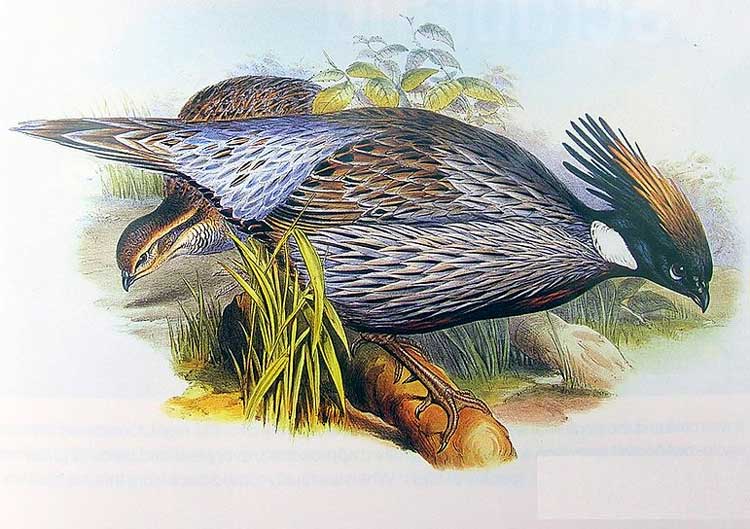
Pucrasia macrolopha
Superregnum: Eukaryota
Cladus: Unikonta
Cladus: Opisthokonta
Cladus: Holozoa
Regnum: Animalia
Subregnum: Eumetazoa
Cladus: Bilateria
Cladus: Nephrozoa
Superphylum: Deuterostomia
Phylum: Chordata
Subphylum: Vertebrata
Infraphylum: Gnathostomata
Megaclassis: Osteichthyes
Cladus: Sarcopterygii
Cladus: Rhipidistia
Cladus: Tetrapodomorpha
Cladus: Eotetrapodiformes
Cladus: Elpistostegalia
Superclassis: Tetrapoda
Cladus: Reptiliomorpha
Cladus: Amniota
Classis: Reptilia
Cladus: Eureptilia
Cladus: Romeriida
Subclassis: Diapsida
Cladus: Sauria
Infraclassis: Archosauromorpha
Cladus: Crurotarsi
Divisio: Archosauria
Cladus: Avemetatarsalia
Cladus: Ornithodira
Subtaxon: Dinosauromorpha
Cladus: Dinosauriformes
Cladus: Dracohors
Cladus: Dinosauria
Ordo: Saurischia
Cladus: Eusaurischia
Subordo: Theropoda
Cladus: Neotheropoda
Cladus: Averostra
Cladus: Tetanurae
Cladus: Avetheropoda
Cladus: Coelurosauria
Cladus: Tyrannoraptora
Cladus: Maniraptoromorpha
Cladus: Maniraptoriformes
Cladus: Maniraptora
Cladus: Pennaraptora
Cladus: Paraves
Cladus: Eumaniraptora
Cladus: Avialae
Infraclassis: Aves
Cladus: Avebrevicauda
Cladus: Pygostylia
Cladus: Ornithothoraces
Cladus: Ornithuromorpha
Cladus: Carinatae
Parvclassis: Neornithes
Cohors: Neognathae
Cladus: Pangalloanserae
Cladus: Galloanseres
Ordo: Galliformes
Familia: Phasianidae
Subfamilia: Phasianinae
Genus: Pucrasia
Species: Pucrasia macrolopha
Subspecies: P. m. bethelae - P. m. biddulphi - P. m. castanea - P. m. darwini - P. m. joretiana - P. m. macrolopha - P. m. meyeri - P. m. nipalensis - P. m. ruficollis - P. m. xanthospila
Name
Pucrasia macrolopha (Lesson, 1829)
References
Dictionnaire des Sciences naturelles 59 p. 196
Vernacular names
English: Koklass Pheasant
español: Faisán koklas
日本語: ミノキジ
The koklass pheasant (Pucrasia macrolopha) is a species of gamebird, being closely related to progenitive grouse that lived during the Miocene. They are distantly related to pheasants and are most closely related to grouse and turkeys. Koklass are the only species in the monotypic genus Pucrasia. Both the words koklass and pucrasia have been onomatopœically derived from the bird's territorial call.[2]
Koklass are boreal adapted species which separate into three distinct species groups. They are one of the few gamebirds that regularly fly uphill and are capable of sustained flights of many miles. They are monogamous with a slight tendency toward social polyandry. Both parents rear the chicks. Koklass are largely vegetarian for much of the year consuming pine nuts, pine shoots, bamboo shoots and seeds. They are highly insectivorous during the warmer months that coincide with nesting and chick-rearing. During this phase of their life cycle they live almost exclusively on ants but also are documented consuming catkins, pollen and fruit.
P. m. xanthospila
Female koklass pheasant (Pucrasia macrolopha)
The koklass pheasant is a polytypic species, with nine recognized subspecies:[3]
Kashmir koklass pheasant - P. m. biddulphi (Marshall G.F.L, 1879)
Western koklass pheasant - P. m. castanea (Gould, 1854)
Darwin's koklass pheasant - P. m. darwini (Swinhoe, 1872)
Joret's koklass pheasant - P. m. joretiana (Heude, 1883)
Indian koklass pheasant - P. m. macrolopha (Lesson R.P., 1829)
Meyer's koklass pheasant - P. m. meyeri (Madarász, 1886)
Nepal koklass pheasant - P. m. nipalensis (Gould, 1854)
Orange-collared koklass pheasant - P. m. ruficollis (David A. & Oustalet, 1877)
Yellow-necked koklass pheasant - P. m. xanthospila (Gray & GR, 1886)
This entry deals with the subspecies P. m. biddulphi, which ranges from Kashmir to Kullu in India. With exception of the subspecies P. m. nipalensis, P. m. castanea and P. m. macrolopha, which are endemic to the southern side of northwest and western Himalaya, the other five are confined to China and Mongolia.
The koklass pheasant is a medium-sized elusive bird confined to high altitude forests from Afghanistan to central Nepal, and in northeastern Tibet to northern and eastern China. Upper parts of male koklass pheasant are covered with silver-grey plumage streaked velvety-black down the centre of each feather, and it has the unique feature of a black head, chestnut breast and prominent white patches on the sides of neck. The females differ from males in above characters and instead their upper parts are covered with pale brown plumage. Both sexes, however, have distinct elongated tails tipped with pale feathers. The males are known to weigh about 1135–1415 g and the females, about 1025–1135 g, with the body length varying from 58 to 64 cm and 18–22 cm respectively. Immature and juveniles resemble adult females in plumage pattern.
Like the western tragopan, it does not extend its range above the tree line. One of the less colourful pheasants, the koklass exhibits moderate sexual dimorphism. Though they skulk under bushes, which makes direct sighting difficult, they give loud chorus/predawn calls during the breeding season and during autumn, revealing their presence and allowing the populations to be estimated.[4] They remain in pairs or small family groups throughout the year. They nest on the ground and spend the nights roosting on trees, or under rock overhangs.
Gallery
Pucrasia macrolopha macrolopha Male at Manila, Uttarakhand
Pucrasia macrolopha macrolopha Male at Manila, Uttarakhand
References
BirdLife International (2016). "Pucrasia macrolopha". IUCN Red List of Threatened Species. 2016: e.T22679179A92805983. doi:10.2305/IUCN.UK.2016-3.RLTS.T22679179A92805983.en. Retrieved 11 November 2021.
Charles William Beebe: A monograph of the pheasants, New York Zoological Society, 1918-1922, Bd. 3, S. 197
Gill, Frank; Donsker, David; Rasmussen, Pamela, eds. (July 2021). "Pheasants, partridges, francolins". IOC World Bird List Version 11.2. International Ornithologists' Union. Retrieved 13 October 2021.
Kaul, Rahul; Shakya, Suresh (2001). "Spring call counts of some Galliformes in the Pipar Reserve, Nepal". Forktail. 17: 75–80.
Retrieved from "http://en.wikipedia.org/"
All text is available under the terms of the GNU Free Documentation License

